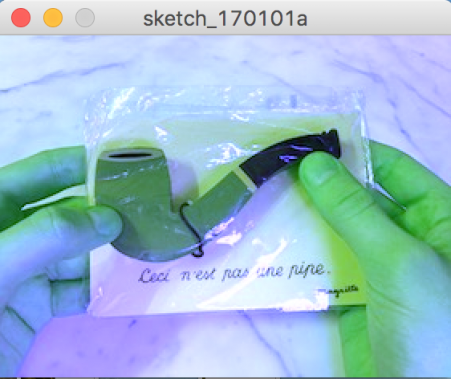Debates around authorship, and who has the power to fix meaning in the communication process, is one of the most contested and explored subject areas within graphic design.
Combine this with digital technologies, and their potential for interaction and audience participation, and you have a dynamic and contemporary field of study. In the first part of the module you've received information about.
The final project has to reflect connection between theory and practice and must relates to the essay question.

As I chose question n°1, "How does meaning get into the image? Where does it end? And if it ends what is there beyound?" (R. Barthes)
My final outcome has to be realized on Processing.
After several hours of practice and exercising codes through it, I have discovered a perfect way that links my project to the essay question which is based on "La rhétorique de l'image" (rethoric of the image) by Roland Barthes:
It allowed me to integrate images and to work on them with an image function that draws an image to the display window of the application Processing after I imported them.
As a result, the color of the image is being modified with a tint function. We can also deform the image when moving the computer mouse around the display window but this function maintains the transparency of the image.
My final project
Subject
Moreover, by pure hazard, I recently found an eraser in a shop in the shape of "Ceci n'est pas une pipe" by Magritte. As I based my final project on the study of the images, I pursued my researches throughout the theory of the "Signifier and Signifed" (Saussure's 'theory of the sign' defined a sign as being made up of the matched pair of signifier and signified), and decided to take a photograph of my hands holding the eraser to recreate a total "Mise en abyme" (therm by the French author André Gidetherm. It developed a number of particular senses in modern criticism).
With Processing I managed to change the pixels and recreate a total "Betrayal of the image".
As a matter of fact, I am holding an eraser in the shape of a pipe but it is not a pipe (a pipe to smoke)!
We can observe that on the black and white effect, Processing has deformed the photograph on tiny little piece of dots/pixels. It goes from a neat photograph to a million pixels photograph and in the end it gives a photograph almost impossible to discern!
I recreated the same experience with a magazine, in which one I found an article about the chair LC4 by Le Corbusier, and we obtained the same results.
To conclude my project, I looked at different eye colors, because different eyes have different data visualizations. I saved an image of people's iris of an eye from the internet, because iris = eye = view = visualization = brain connection = analyze = data informations, and I applied different Processing pixel effects to it.
Furthermore, there is something interesting beyond these experiments, it pushes us to question ourselves on what it is until we can see the original image (= the blue eye).
Processing has helped me to realize amazing and interesting visual effects through the manipulation of pixels of an image, and I think I managed to collect enough data visualization in connection between theory and practice related to my essay question.
Menu
If we drag the image to the top right of the display window, the image is deformed to its maximum...
little by little...
if we drag the image down right the display window, we can observe that the shapes are appearing clear and the image is appearing in its original form.
Menu